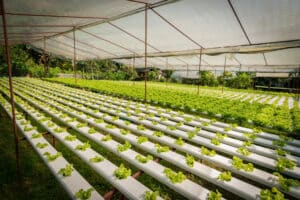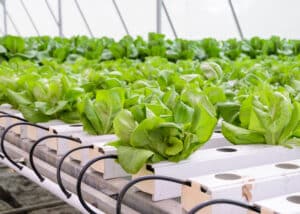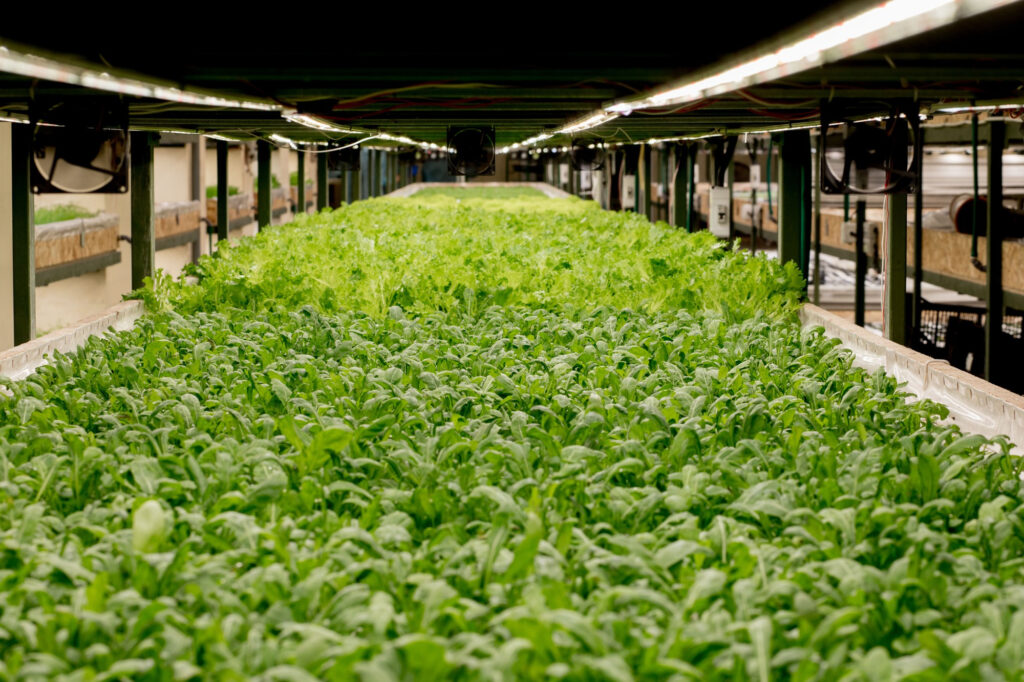Farming has been done the same way for centuries and we can definitely see the flaws that has been hidden for centuries. With climate change making weather more extreme, water becoming a rarity, and cities taking up much of the land where farms once flourished, it is clear, agriculture is in need of a transformation.
Hydroponic farming, an old method of food production but gaining in popularity, is growing food without soil, in most cases stacked vertically, and a shockingly less amount of water than growing it in soil. For countries like the UAE, where fertile land is scarce and water comes at a high cost, hydroponic agriculture is more than just a trend ,it’s a solution.
Table of Contents
- Introduction
- What is Hydroponic Agriculture?
- Why Water Isn’t Wasted in Hydroponics
- Farming in Tight Spaces? Hydroponics to the Rescue
- Resource Efficiency: The Smart Farmer’s Toolkit
- Why the UAE is Betting Big on Hydroponics
- The Role of Farming Companies in UAE
- Hydroponics vs Traditional Farming (Comparison Table)
- Conclusion
- FAQs
What is Hydroponic Agriculture?
Hydroponic agriculture is essentially using water and nutrients to grow plants instead of soil. The roots are either floating in water or in an inert medium like coco coir or clay pellets. Each drop of water is precisely controlled, and each bit of nutrition is measured out.
It may sound like something out of a science lab, but hydroponics has actually been around for decades. What’s new is its massive potential to help countries, especially arid ones like the UAE, to grow food smarter, not harder.

Why Water Isn’t Wasted in Hydroponics
Let’s talk numbers. Traditional agriculture can guzzle up to 70% of global freshwater, and a good chunk of that is lost to runoff, evaporation, and overwatering. With hydroponics? Not so much.
In a closed-loop system, water is reused. Plants absorb what they need, and the rest goes back into circulation. There’s almost no waste. That means hydroponic farms can use up to 90% less water than soil-based farms, a huge plus in regions where water conservation is a must.
In the UAE, where much of the water supply comes from costly desalination, hydroponic farming in UAE is a water-wise game-changer.
Farming in Tight Spaces? Hydroponics to the Rescue
Land is a precious resource, especially in larger urban cities and desert nations. Hydroponics is unique in that you don’t need open fields to successfully grow crops. You can grow vertically in towers, on rooftops, or in shipping containers,
This concept of growing up instead of out means hydroponic farms can grow more crops per square meter and limit transport emissions and spoilage, providing people with fresh food closer to home. For a region like the UAE, where building vertically is second nature, this farming model fits right in.
Resource Efficiency: The Smart Farmer’s Toolkit
Hydroponic systems are precise. Want to know how many nutrients your lettuce needs today? The system tells you. Is it too humid for your spinach? Adjust the environment with a tap.
The regulated environment of hydroponic farming decreases the amount of pesticides needed, creates less fertilizer waste, and allows plants to grow quickly and often in half the time it takes growing in soil. And because you’re not using heavy machinery, you’re not working on large pieces of land, the operation is labor-light, and you also have operational savings. That’s a win-win for the farmer and the planet.
Why the UAE is Betting Big on Hydroponics
The UAE imports 80% of its food supply. That is a significant figure and a significant risk. With global supply chain issues and rising import costs food security is an increasingly pressing concern.
 That is why the UAE is fully embracing hydroponic farming, whether it is subsidy from government or start-ups or independent forwarding in a free market system. The aim is to grow fresh, clean food locally and with a very low resource footprint.
That is why the UAE is fully embracing hydroponic farming, whether it is subsidy from government or start-ups or independent forwarding in a free market system. The aim is to grow fresh, clean food locally and with a very low resource footprint.
Hydroponics not only helps reduce dependency on imports but also provides consistent, year-round yields, regardless of harsh desert conditions.
The Role of Farming Companies in UAE
Some leading farming businesses in the United Arab Emirates are paving the way towards a more sustainable future. They are making cleaner, faster, and better harvests using smart technology and agricultural science. Harvests take the form of vertical farms in Dubai and AI greenhouses in Abu Dhabi.
Companies using this approach include Madar Farms, Badia Farms, and Pure Harvest Smart Farms. They are developing climate-controlled systems, apps for renewable energy, and precision agriculture tools to make hydroponics feasible and economical. And the best part? They’re doing it all while conserving the region’s most limited resource, water.
Hydroponics vs Traditional Farming
| Feature | Traditional Farming | Hydroponic Farming |
| Water Usage | High | Up to 90% less |
| Land Requirement | Extensive | Minimal (can be vertical) |
| Pesticide Use | Often required | Rarely needed |
| Crop Yield | Variable | Higher, more consistent |
| Growth Speed | Seasonal | Year-round, faster |
| Environmental Impact | Moderate to high | Low |
Conclusion
Hydroponics isn’t just a method of farming. It is especially designed for the areas that doesnt have fertile soil or unlimited access to water. Due to it’s attributes of using less water, more efficient land, and has a lower environmental footprint, it has become a sustainable farming method. Hydroponic agriculture is a feasible and innovative solution to food security challenges. In the UAE, hydroponics is more than a cool trend; it’s a move toward food sovereignty, sustainability, and smarter urban living. Hydroponic systems are being adopted by more farming companies in the UAE every day. Hydroponics will be normal, not an exception.
FAQs
1. How does Hydroponic agriculture conserve water?
Hydroponic systems recycle water; they are a closed-loop solution that utilizes 90% less water than conventional agricultural techniques while also reducing waste.
2. Is hydroponic farming appropriate for arid regions like the United Arab Emirates?
Indeed! It requires less water and doesn’t rely on soil. Hydroponics is a great technique for arid regions. This makes it ideal for hydroponic farming in the UAE.
3. What are the best crops to grow in hydroponics farms?
Leafy greens, herbs, strawberries, and tomatoes are top performers in hydroponics, thanks to their fast growth and compact size.

Pingback: Hydroponic Farming vs Traditional | Pros, Cons & Agriculture
Pingback: Hydroponic Farming ROI: Costs, Profits & Payback Time